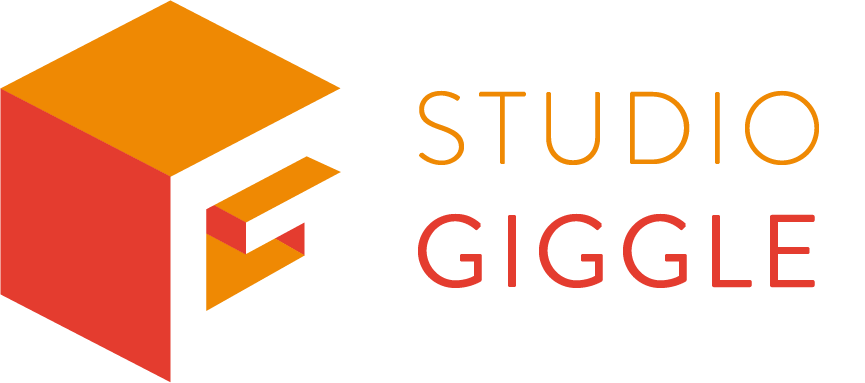Part 1 of 3… alpha to frame rates.
Producer Dave sat down with Ed Vosper and Iina Kuula, who are both designers and animators at Studio Giggle, to massively distract them and answer some terms that our clients often get muddled. Animation is seen as smoke and mirrors – so let us waft away some of the smoke and remove a few of the mirrors…
D: The first word is Alpha or alpha channel:
E: Ok, so this is a transparent layer…
I: It’s adding invisibleness. So if you have a logo for instance, the background doesn’t need to be a certain colour it can just be nothing.
Animatic:
E: This is the next stage after storyboarding. It’s a moving storyboard that helps the animators time the visuals to the voiceover.
I: We don’t always do them, but they are useful.
E: If you don’t have an animatic you are effectively baking a cake but with no recipe.
After Effects
I: This is the main animation software and content creation tool that we use to make motion graphics.
Aspect Ratio
E: So a standard screen’s aspect ratio is 16:9, which is the width by the height.Old school TV’s were more square, 4:3, and instagram is 1:1, so a square.
I: Not everything we make is 16:9, when we do events the screens can vary so we need to know this before we start. It can be 14000×1080 if we are projecting on the moat wall at the Tower of London!
E: Yeh, everything online or on TV is usually 16:9 though.
Assets:
E: In terms of clients giving us assets, these would be anything to do with their brand. So logos, fonts, colours, videos, images they want to show, music, any ingredients that they are providing.
Blending Modes:
I: Bending modes are basically how 2 layers are mixed together. It’s hard to explain! So say I had a logo on a black background, but I wanted it on top of an image, i’d add a blending mode to the logo.
D: So instead of slapping images on top of each other they are more meshed seamlessly.
E: Hang on can we call this blog “Know Your Onions”? It just came to me…D: Sure!
Colour Pallets:
E: When you are working with a brand, they usually have strict guidelines on what colours you are allowed to use. Let’s take Coca Cola, they have a strong Hex Code (see further down) for Red. You need to use that specific red, everyone knows that red. It’s the rule. So that’s the main colour in their palette.
D: If we were making an animation with Coca Cola, they’d most likely tell us to use their red, and lot of it. They might even have guidance on other colours too.
I: Quite often companies now have a primary palette, which is the main colours, and a secondary palette, for their complimentary colours. I think when we worked with Facebook there was a blue, white and grey in the primary palette and then brighter colours in the secondary palette.
D: More often than not if a client gives us their brand guidelines the palettes will be in there.
Colour Wheel
E: So the colour wheel was invented by a man… his name escapes me! But he was an artist who invented the colour wheel which is a spectrum of colour. It’s used to balance your colour.
D: It looks like a rainbow, is it every single colour?
E: Almost, in-between the colours you see the blends. It’s good for seeing what colours compliment each other and which clash.
D: Which are you favourite colours combos?
I: Blue and orange.
E: Orange and purple for me – It reminds me of Liverpool’s away kit!
D: (Man U fan) Hmm…
Compositing:
E: I think it was the French who came up with this word… Le Composite was it? haha!
I: It’s where we take all the elements that we have created, and start compiling them on top of each other onto one scene.
E: The way I look at it, it’s like a theatre set. So if we were comping a park scene, you’d have your trees, and your sky and your bench, and then your characters in the foreground. It’s bringing them all together to create one scene. You’re kind of layering up paper.
I: There can be so many layers, maybe 5 or maybe 50.
D: Is this where your separate work comes together then? Because sometimes you’ll be creating elements separately, and then during compositing it comes together…?
E: Yes, when we worked on the OVO project we worked separately to build the set and then brought everything together
I: Yeh, when we made the Giggle Christmas card too, we were more comfortable making different kinds of elements but it all comes together in the end.
Cycles:

I: Ed cycles to work every day!
D: Please don’t make jokes on the blog…
I: Haha! Well it’s a kind of loop. So a piece of animation that will just loop over and over.
D: So these are useful in padding out films?
E: Exactly, let’s say you were animating a plane, you wouldn’t want to keep animating the propeller, you’d only want to do it once, then you can just loop it.
DPI:
I: Dots per inch. This is used mainly in still imagery and photos, it’s kind of like resolution. How many coloured dots you have in a square inch of an image.
E: It’s mainly for print. It’s information the printer needs.
I: 72 DPI is resolution for screens, and 300 is the resolution for print.
D: So it’s definitely something clients need to consider, if they want us to print something that we’ve made, like with Sky when we designed all the print for the walls…
I: And when clients are giving us logos. They ideally need to be at least 72 DPI so that they are good enough quality to be displayed on screen. Vector images are best (more on that in a later chapter).
Explainer Films:
I: That’s self explanatory!
D: Is there anything else to it?
I: Well it’s a film that explains a process, a product, or how something works.
E: We often make explainer films about subjects that are really complex, and would be too long to read about, or even to verbally explain on camera – so we can explain the topic using visuals and voiceover, it’s a good way to ingest an idea.
D: So you are boiling everything down, removing any jargon, removing any waffle and relying more on visuals…
E: Yeh, it’s this combination with visuals that make it a perfect tool to explain something complex.
D: So how long is a good explainer film?
E: As a general rule, 2 minutes is the most you ever want to do, unless there was tonnes of information, but you aren’t going to keep someone’s attention much longer than that.
I: 1 minute!
Frames/ Frame rate:
E: A frame is a one image in a sequence. Back in the day this was a spinning wheel loaded with images, and when you spun it the images would blur together and give the impression of motion. For the human eye you roughly need 24 frames a second for the human eye to recognise smooth motion. This is the standard PAL FPS rate.
D: So most films in the cinema (depending on what country you live in), and most of the films we make, are 24 or 25 frames. What about when we film things slo-mo?
E: Yeh, so if we ever used something like a Phantom camera, and were filming at 1,000 frames a second, it’s taking so much more information in.
D: And then when this is on a 25 frame timeline you’ve spread those frames out so it’s looks really slow. Do we ever venture down from 25 frames?
I: Yeh, it’s sometimes a stylistic choice, if you want your animation to look more handmade, it adds more character to it.
D: So 25 frames is our standard, do clients need to worry about this?
E: Anything for web – no, even for events 25 has become a norm. Sometimes LED screens work work at 50hz refresh rate therefore we work at 25 fps as it is divisible. Sometimes our programmers ask us to render out at 50 fps but this would mean double the render time for not much quality uplift so we often politely decline! It’s only really broadcast where a client would need to be specific. I would say if there is a reason for differing from 25 frames, just tell us because this can be tricky to fix once the project is underway.
And that’s it for now… we’ll put up part 2 soon with more animation terms :-)


